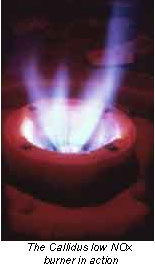Development of new low-NOx burner from Callidus Technologies Inc. nearly complete


"Work on this project began in mid-1994," says Dr. Richard Martin, the lead engineer for Callidus, "and now the burner is ready for industry applications. With this technology, we're able to achieve single-digit NOx levels."
The burner, which will go on line in early 2001 at a major refinery in Houston, incorporates an ultra-low emissions approach that offers significant performance improvements over conventional low-NOx burners. Designed for natural draft operation, the burner has a continuous pilot, and there is no recirculation of external flue gas.
"This burner will be the new industry standard," says Chuck Benson, of ADL. "It's exciting to see this concept of extremely low emissions become reality in a very reliable, affordable technology."
An earlier version—a 2 MMBtu/hr prototype burner—was successfully demonstrated in 1995-96 by Arthur D. Little and Sandia Livermore's Burner Engineering Research Laboratory. Measurements by the program team demonstrated extremely low levels of air toxics. The design was developed using comprehensive chemical kinetics and CFD modeling tools.
Initial testing of the full-scale prototype produced similar results, with NOx emissions below 10 PPM on natural gas fuel. In November 1999, three U.S. patents were granted protecting the burner technology. GRI will retain the patents and Callidus will have exclusive licensing on the design, manufacture and marketing of the new burner. The new technology is appropriately named the Ultra Blue burner. Under the new proposed 90% NOx reduction requirement regulation for the Houston, TX, area, the new Callidus Ultra Blue burner is estimated to reduce implementation cost by 100's of millions of dollars alone.
"We will be testing and optimizing this commercial burner throughout the summer at our test facility, with verification testing scheduled for fall," notes Bill Bartlett, president of Callidus Technologies. "We also anticipate being able to conduct demonstrations for interested customers."
For more information about Callidus, go to http://www.callidus.com
Edited by David Nakamura
Managing Editor, Hydrocarbon Online
